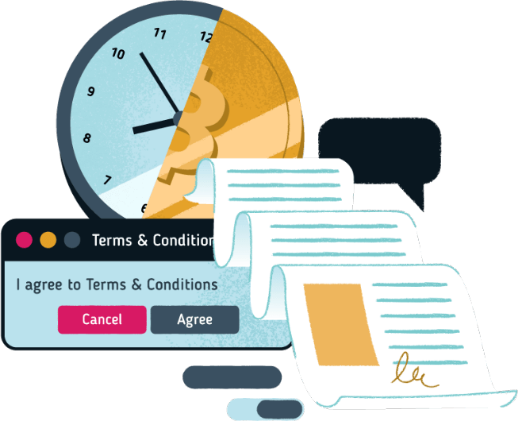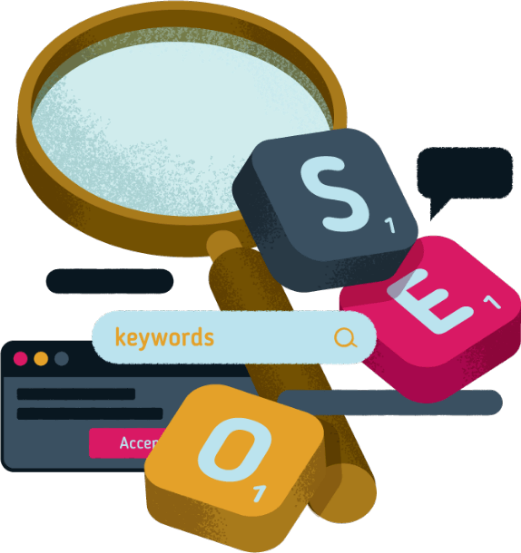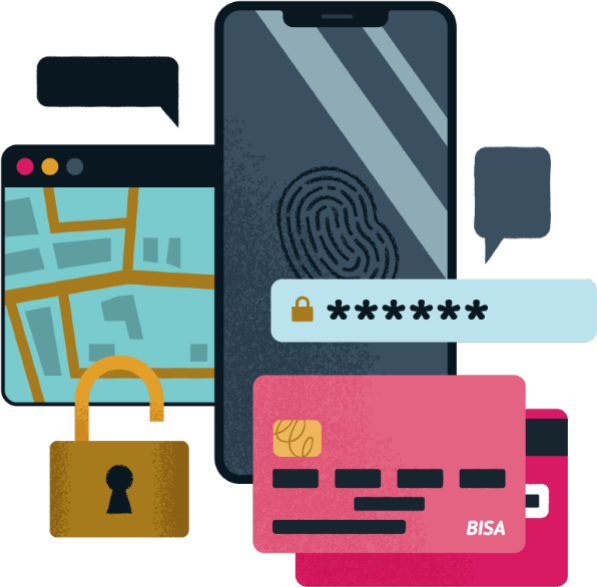
Over the past 15 years, digital marketing has changed. Big Time.
Social media, smart phones, augmented reality, big data and other transformative technologies have altered the landscape and disrupted established industries everywhere.
The latest of these disruptors?
Blockchain
While blockchain is usually associated with Bitcoin,
it’s a lot more than that.
What’s a blockchain?
At base level, a blockchain is a data storage system—a sort of digital ledger owned by a community and secured by cryptography. (A ledger, BTW, is an accounting tool that’s been used for hundreds of years to record business transactions).
Why are they created?
Blockchains are usually created to store and verify ledgers for all sorts of information-heavy items of value: financial transactions, medical records, contracts, real estate and yes, cryptocurrency.
Are they effective?
You bet. In fact, it isn’t far-fetched to see blockchain technology taking over all online transactions in the next decade.


How it works
Blockchains work according to 3 pillars. These are:
1. PEER-TO-PEER DECENTRALIZATION
Data in a blockchain is exchanged in a peer-to-peer model with no middleman in the picture. This differs from a centralized or client-server model, in that data sent from one party to another isn’t managed and sent via a 3rd party like a bank or a government ministry. Instead, files are transferred directly from one user to another.
2. TRANSPARENCY
Since a blockchain is a distributed digital ledger, users in the blockchain can see every transaction that’s taken place. Privacy rules mean that users can’t see one another’s identity, however.
3. BLOCKCHAINS ARE IMMUTABLE
A blockchain has a built-in mechanism for ensuring the accuracy of the data it contains. Here’s how it works:
- Each page, or “block” of the ledger starts with a summary of the page that precedes it. If a page changes, the summary must also be changed, meaning the “blocks” are “chained” together. (This is where the name “blockchain” comes from.)
- Every addition or change to the blockchain is timestamped.
- Changes to data are recorded in new blocks, which means any data contained in previous blocks can’t be destroyed or altered.
What this means is, if someone tries to hack any block in the chain, the blockchain will automatically update the blocks connected to it. A successful hack would mean altering records in every block, something that is practically impossible.
WHY GO TO ALL THIS (SEEMING) TROUBLE?
TRUST.
The security of a blockchain creates trust in the data it contains.
Trust is the backbone of commerce. One party has to trust another before a transaction can occur. The difference here is that in most areas of commerce, trust is governed by centralized authorities like banks or governments.
Since the data in a blockchain is immutable and trustworthy, however, the need for a central authority vanishes. Instead, trust is put directly into the hands of the two parties transacting via the Blockchain.


Types of Blockchains
There are 3 types of blockchains:
PUBLIC
Blockchains that anyone can view and access.
Example: cryptocurrencies such as Bitcoin.
PRIVATE
Blockchains that are open only to a group of authenticated users.
Example: Individual companies or banks that leverage blockchains for an internal project.
HYBRID
Blockchains that offer a mix of public and private access.
Examples: A blockchain that gives authorized users full access, while the public can only access a subset, or a blockchain that is viewable by the public, but can only be updated by authorized users.
In practice, this could be a housing registry using a blockchain to grant public access to a subset of its data, but only allow authorized users to view and update the complete data set.
Real world applications for blockchain
RISK MANAGEMENT
Blockchain technology can help reduce the risk of fraud when managing digital identity documents, such as:
- Passports
- Birth Certificates
- Credit cards
- Driver Licenses
- Health Insurance Cards
- Avatars and digital profiles
This is key, when you consider that fraud—caused by hacked databases, ransomware, etc. —costs consumers nearly $60 billion a year.


SMART CONTRACTS
Blockchains also show promise when it comes to smart contracts — programmable digitized documents that automatically execute when their terms and conditions are met. These are trackable, irreversible and contain all terms of an agreement.
Since smart contracts are self-executing, middlemen are eliminated, saving money, time and permitting funds to be released immediately after goods and services have been delivered.
Goodbye invoicing!
A FEW MORE BLOCKCHAIN APPLICATIONS INCLUDE:
Auto and real estate title transfers

What’s in it for digital marketers
Here are 5 areas in digital marketing that are being disrupted by blockchain:

ADVERTISING VALUE
Digital advertising is more or less broken. Ad buyers routinely lose money to fraud, fake impressions and clicks, ad stacking, domain spoofing and pixel stuffing. The result is high spend, inaccurate metrics and low ROI.
Then you’ve got platforms like Google and Facebook overstating impressions and video view metrics in order to drive their own profits without providing commensurate value.
In short, the system isn’t providing value.
HOW BLOCKCHAIN CAN HELP
Here again blockchain can help curtail fraud, since data corruption is practically impossible. Blockchains will allow companies to bypass ad networks and work directly with companies that have space and inventory available on their digital properties.
WHO’S USING IT?
Corporations like Kellogg, Kimberly-Clark, Pfizer and Unilever, as well as McDonald’s, Nestlé, Virgin Media and Toyota are studying the use of blockchains to improve online ad transparency, efficiency and reduce fraud. What’s more, it appears to be working.

INFLUENCER AUTHENTICITY
Influencer marketing has now grabbed a large piece of the marketing mix. Unfortunately, it has an inherent credibility problem: how can you accurately track true influencer ROI? Due to dodgy partnerships, fake social followers and fake engagement, influencer marketing can be a crapshoot.
HOW BLOCKCHAIN CAN HELP
Blockchain can solve these issues by:
- Helping verify an influencer’s performance and legitimacy, by accurately tracking engagement with their posts.
- Introducing smart contracts into the influencer ecosystem. This could allow for scenarios where influencers only get paid after they’ve hit a marketer’s target number.
WHO’S USING IT?
Companies like Patron and indaHash have started using blockchain to help brands verify influencer value, while others like Socialmediamarket offer an Ethereum-based platform that adds dispute-resolution to influencer engagements.

SEO
SEO’s biggest challenge is keyword tracking. However, keyword tracking has long suffered from inconsistencies that can make perfecting SEO a major challenge.
For starters, Google algorithms aren’t static. This means marketers must continuously course-correct their SEO approach. Another stumbling block is the fact that most people have and use multiple devices, making it a challenge to track keywords, not to mention distinguishing between local and national searches.
HOW BLOCKCHAIN CAN HELP
- Blockchain is showing great promise in tracking keywords and generating precise, device and location-agnostic statistics. This is a major leg up for marketers when creating strategies and campaigns.
- Blockchains can also power search engines themselves. A great example is, Presearch, a platform built on a blockchain that pays people to search on it.

CUSTOMER DATA ACQUISITION AND SECURITY
These days, it can feel like there’s a huge data leak practically every week. When we hear about them, we ask ourselves, “Has my identity or financial information been compromised?” and “Should I give my personal information to this company?”
Unfortunately, data security is a growing issue, resulting in personal uncertainty and low levels of trust for marketers and consumers alike. Here again, blockchain offers some solutions.
HOW BLOCKCHAIN CAN HELP
- Blockchain can provide new layers of accuracy and data security acquisition.
- Blockchain can also let consumers charge money for their data—ensuring only companies they want to give it to, can access it.
While this may sound like a new barrier to data for marketers to overcome, it means that instead of wasting money on dirty data, fake profiles and uninterested consumers, companies will get targeted, accurate information from people who are actually interested in their goods and services.

SOCIAL MEDIA SECURITY
For more than 15 years now, people have been posting, sharing and accessing content through centralized social media platforms like Facebook, Instagram, WhatsApp and Twitter. While this has its social benefits, it also has its warts. The list is long: data breaches, misinformation, bots and fake profiles, privacy issues, account hacking ransomware, ad fraud, you name it. The associated headaches are heavy duty.
HOW BLOCKCHAIN CAN HELP
Blockchain can offer “decentralized” social media to alleviate the issues by providing a more secure environment. It can also give content creators the ability to directly benefit from the value they generate.
Some blockchain-based social media examples:
- Minds: Offers all of Facebook’s features with no centralized surveillance
- Bitclout: Mixes speculation and social media by allowing users to ‘buy into’ other users’ value via cryptocurrency
- SoMee: A gamified network with multiple monetization options via “gravitational pull”, a proprietary algorithm
- Diaspora: A highly secure node-based network
- SocialX: A platform that rewards users by paying for engagement and quality content
While it’s highly unlikely any of the above will ever pose a real threat to Facebook’s dominance, they and others like them will alter the social media landscape simply by showing users how social media can, and should operate.
HOW DO I GET IN ON THE BLOCKCHAIN GAME?
Blockchain As A Service. (BaaS)
If you’re interested in putting the security and flexibility of Blockchain to work for you, BaaS is a great way to go about it. BaaS offers the ability to leverage cloud-based solutions to help you build and host your own blockchain apps and related functions. And, since it’s based in the cloud, the infrastructure is agile and highly functional.
Notably, the blockchain-as-a-service market is set to reach 25 billion USD in 5 years. Wow.
Who’s using it?
Companies offering BaaS now include heavy hitters like:
Also in on the action are niche players like Dragonchain, Bloq and Factom.

Want to learn more about Blockchain
and your digital marketing efforts?

